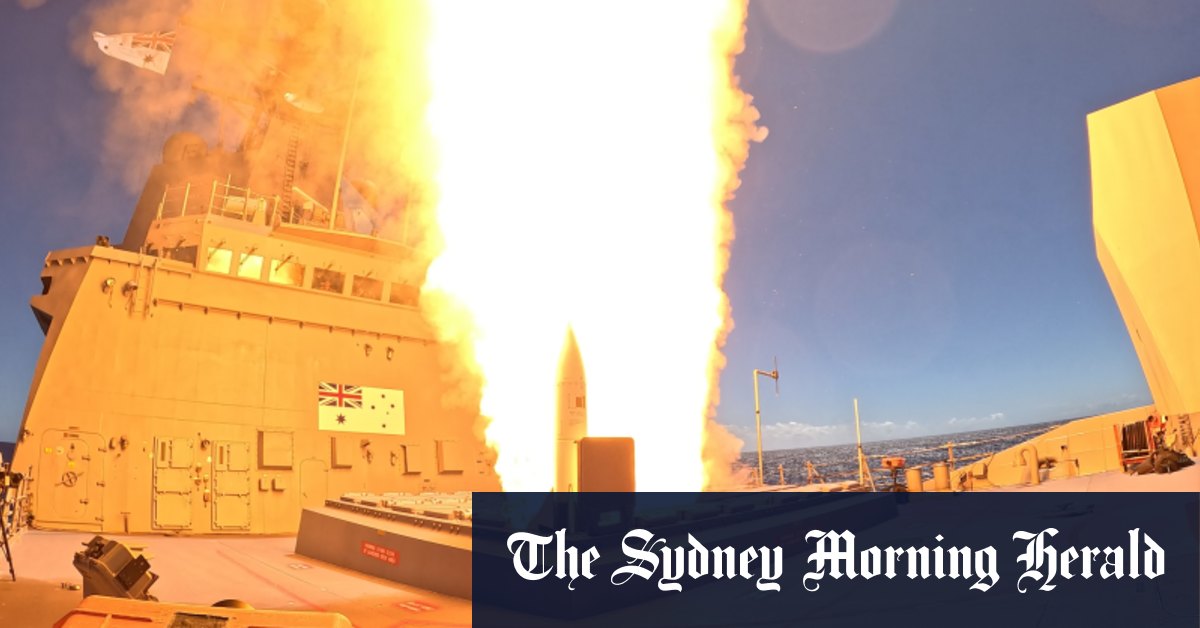Australia buys $7b worth of US missiles for ‘greatest arms race’ since World War II

- by Admin
- October 21, 2024

Australia will spend $7 billion on a stockpile of long-range missiles from the United States to strengthen its defence capabilities, with Defence Industry Minister Patrick Conroy warning that the world faced the biggest arms race since World War II.
The deal, announced by Conroy overnight in Washington DC and approved by Congress, allows Australia to acquire a suite of hundreds of SM-2 IIIC and SM-6 US-made long-range weapons for the navy that can be fired from land or ship, described by Defence Minister Richard Marles as “the most advanced air and missile defence weapons in the world”.
HMAS Sydney fires Royal Australian Navy’s first Standard Missile 6 (SM-6) near Hawaii during Exercise Pacific Dragon 2024.Credit: ADF LSIS Daniel Goodman
The SM-2 IIIC missiles have a range of 160 kilometres, while the SM-6, with a range of 370 kilometres, was already tested on Australia’s fleet last year. They are capable of targeting and destroying aircraft or incoming missiles in midair. According to manufacturer Raytheon, the weapons have been sold to nations including Canada, Germany, Japan, Korea, Netherlands, Spain and Taiwan.
“Australia faces the most complex geo-strategic environment since the Second World War”, Conroy said in a statement. “Our investment in these world-leading, high-tech missiles is another example of the Albanese government moving fast to keep Australians safe, deter any adversary, and defend Australia’s national interests in the missile age.”
At a press conference in Washington, Conroy refused to say when the missiles would be deployed on Australian warships, saying it could not be disclosed “for operational reasons”. He added that countries in the region had been expecting this announcement and would not be taken by surprise.
Conroy told the Australian Financial Review: “We live in the greatest arms race in our region since 1945 with a high degree of strategic uncertainty” and argued the missiles’ purpose was deterrence.
Marles has said Australia needs to become a “porcupine island” fortified with enough lethal weaponry to prevent an attack from a hostile rival.
Defence spending will soar to $100 billion a year within a decade – double current levels – after the Albanese government directly identified China as the biggest threat in the Indo-Pacific in the new national defence strategy unveiled in April.
While Tuesday’s announcement did not mention China by name, the defence strategy calls out China for employing “coercive tactics in pushing its strategic objectives, including forceful handling of territorial disputes and unsafe intercepts of vessels and aircraft operating in international waters and airspace in accordance with international law”.
The Latest News
-
December 25, 2024Where to watch Australia vs. India 4th Test: Free live stream, free-to-air channel, start time for cricket match | Sporting News Australia
-
December 25, 2024Gearing Up for Australian Open, Nick Kyrgios Elevated in Bold Predictions From Renowned Tennis Experts
-
December 25, 2024Dads’ day out! Australian stars unwind with with wives, kids at MCG. Watch | Cricket News – Times of India
-
December 25, 2024Border-Gavaskar Trophy: What is Australia’s record in Melbourne in Test matches? | Sporting News Australia
-
December 25, 2024India must continue to exploit ‘brittle’ Australian line-up: Ravi Shastri | Cricket News – Times of India





